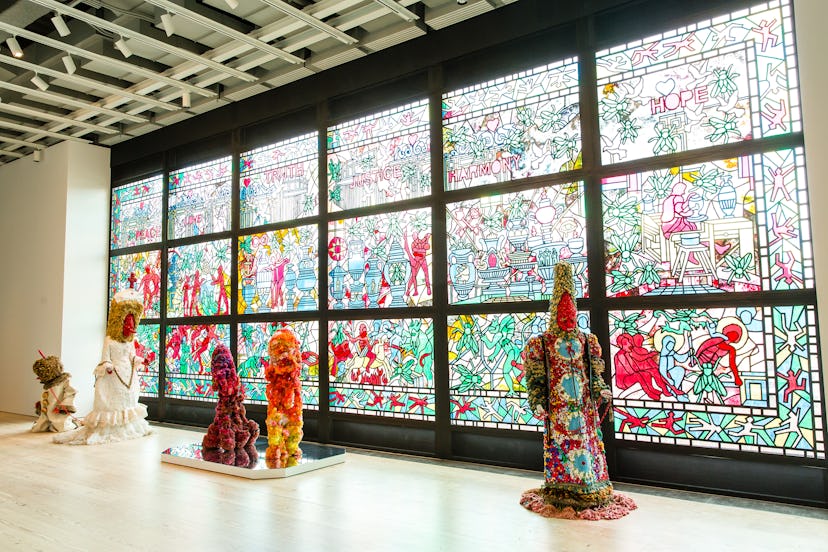An Early Look at the 2017 Whitney Biennial, Arriving in Time to Tackle America’s Turmoil
The first biennial in the Whitney’s new building, and the first in 20 years to coincide with a Presidential election.

Given that its role is to capture the zeitgeist, the Whitney Biennial has been called many things—provocative, bewildering, and even polarizing—since its inception in 1932. The lead up to the latest edition, opening March 17, was the first in two decades to coincide with the U.S. presidential election, so expect a tumultuous ride. “Many artists right now are trying to negotiate this tension between preserving a private self and coming together into collective actions,” said the independent curator Mia Locks, who with Christopher Y. Lew, an associate curator at the Whitney, organized this year’s Biennial after visiting artists’ studios, dealers, and curators in some 40 cities. “They’re asking, ‘Who are we as individuals? Who are we as a community?’ and reconsidering fundamental things that we maybe took for granted.”
Among the 63 artists featured working in various media, are established artists like Americans Larry Bell and Dana Schutz, up-and-comers like Torey Thornton and Shara Hughes, and collectives like the Gulf-based GCC and the American trio Postcommodity. The latter is best known for installing a two-mile “Repellant Fence” of 26 balloons along the U.S.-Mexico border; at the Whitney, it will show “A Very Long Line,” an immersive and discordant video projection that spins around all four walls of a room to convey the point of view of a passenger in a car driving along that same hotly-debated/contentious border.
Installation view of Henry Taylor, The 4th, 2012-2017 and THE TIMES THAY AINT A CHANGING, FAST ENOUGH!, 2017. Courtesy Blum & Poe. Whitney Biennial 2017. Installation view of Deana Lawson, Ring Bearer, 2016. Courtesy Rhona Hoffman Gallery, Chicago, and Sikkema Jenkins & Co., New York. Whitney Biennial 2017. Photographs by Matthew Carasella.
The connection to place is another theme running through this biennial. Raul de Nieves, who was born in central Mexico and migrated to San Diego at the age of nine, connects with his Mexican heritage via works that ruminate on transience and rebirth. A wall of stained glass windows, made from humble “craft” materials like tape, paper, beads, and photo-gels, plays on the idea of metamorphosis with a fly as its central motif. “Flies are always surrounded by the idea of disease and fear,” he said. “They’re annoying, something we don’t want to think about. But in a way they symbolize humility and the act of being human.” Look for his coral-like shoe sculpture, built over years using tiny plastic beads, and the mesmerizing processional of religious figures, made from pressed yarn or beads, that double as costumes in his performance works.
The Los Angeles-based painter Henry Taylor, meanwhile, turns his gaze on the communities he knows—whether the patients at the mental hospital where he once worked or, more recently, people from the streets around his studio in downtown L.A. Maya Stovall, an anthropologist and choreographer, dances in front of liquor stores in her neighborhood on the east side of Detroit, before interviewing local patrons and passersby about the city, the streets around them, and the place of art in their lives. The result is “Liquor Store Theatre,” a series of videos made over four years that combine Stovall’s performances, interviews, and observations. Her performances, she said, “became part of the scene of the neighborhood,” which creates a level of comfort with her subjects, many of whom invited her into their kitchens to talk.
Other biennial works are designed to incite psychological dislocation. Kaari Upson’s gnarled, recast sectional couches, her last in a series of furniture sculptures, will sprawl over a gallery “like an infection, turning the idea of comfort inside out,” said Locks, while Samara Golden‘s disorienting installations create a sense of “dropping into the abyss.”
Installation view of Samara Golden at the Whitney Biennial.
With mirrors on the ceiling and floor that produce an infinity chamber, Golden’s “The Meat Grinder’s Iron Clothes” spans some 33 x 14 feet and features a series of stacked domestic spaces rising from a grim hospital room and office to a cozy apartment and luxury penthouse. The psychological states induced by domestic spaces has been a theme in her work, inspired in part by her experience assisting her father, a commercial photographer, in documenting nursing homes. (Golden arranged the scenes.) Her idea was to put these rooms, or “classes” as she thought of them, on top of each other so that through making the piece a sense of cohesion would emerge. “But,” said Golden, “given the constant news cycle lately, I realized that the way we function in America isn’t resolvable. There’s endless confusion about how to be in this world, if you have a choice.”
Perhaps the most unnerving work you’re likely to experience is Jordan Wolfson’s “Real Violence.” Experienced via a VR headset, it depicts the artist savagely beating another man. The project grew out of Wolfson’s interest in removing the possibility of interactivity from an interactive medium, which led him to think about the sense of horror we feel at witnessing violence, whether in real life or via the images that flood us daily. To recreate what that act of witnessing might feel like, the artist built and filmed an animatronic dummy; in post-production he altered the footage using 3-D face-swapping technology—that is the face and hands of a human actor. The goal was to make the immersion as real as possible. Wolfson called the 90-second work a “body sculpture”—it heightens sensation in the viewer’s body and sparks a physical and contextual distortion. When it comes to its abrupt end, “you might want to jump and look behind you and ask, ‘What have I just seen?’” he explained. “But nothing’s there. And then you take off the headset and suddenly you’re in the museum space and everything is different. It’s disorienting.”
Installation view of Ajay Kurian, Childermass, 2017. Whitney Biennial 2017. Photograph by Matthew Carasella.